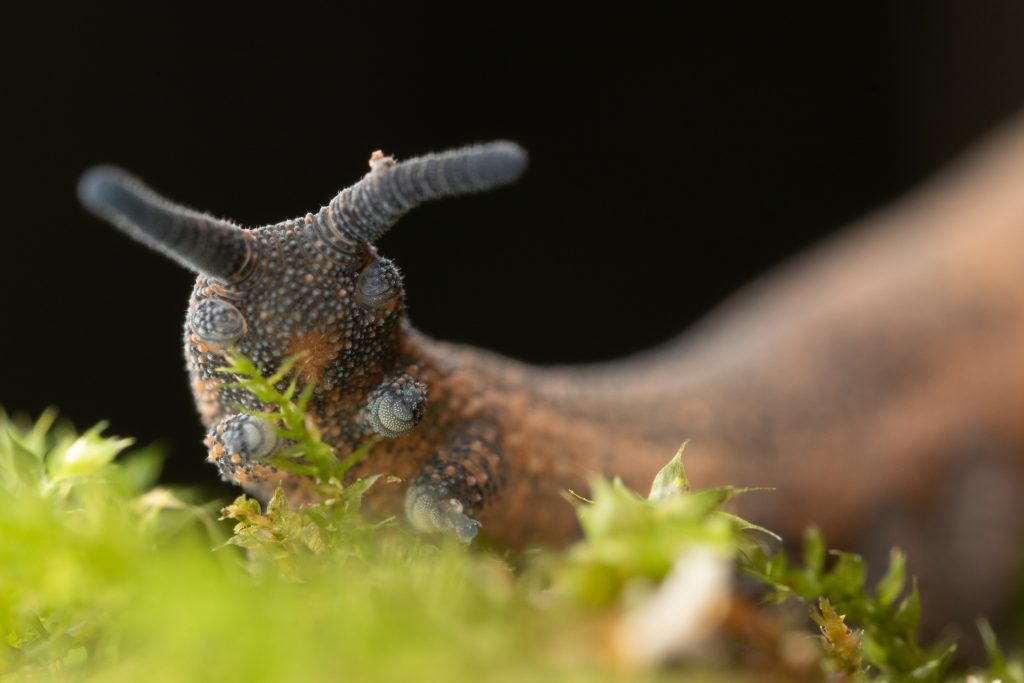The Bug of the Year
An ancient gummy-looking worm-like creature with a vicious hunting method that involves projecting sticky glue from its head, the New Zealand velvet worm, has been crowned this year’s Bug of the Year. Words Annie Studholme, Photos Samuel Purdie.

There’s a reason the New Zealand velvet worm has remained virtually unchanged for more than 500 million years. It’s because they’re perfect just the way they are, says Tūhura Otago Museum Natural Science Collections Technician On Lee Lau, who led the museum’s successful Bug of the Year campaign. ‘It’s one of those hidden treasures that the more you learn about them, the more you come to love them. They’re not bugs you see daily, but they play an important part in our ecosystem. You have to appreciate their unique biology – they hunt with sticky slime – but they’re cute as a button too, with stubby legs and a soft body covered in velvety skin, which is how they got their name.’
On Lee first learnt about velvet worms in Costa Rica in 2003 and has been fascinated by them ever since. Dunedin’s connection to the terrestrial creatures began in 1988 when local resident Dave Randle discovered hundreds of velvet worms in his Caversham garden. This led to the creation of the first reserve dedicated to protecting the velvet worm, setting a precedent for conservation efforts in New Zealand.
Despite its common name, velvet worm is not a worm. Nor is it a slug, a caterpillar, or a millipede. It’s something different. Something so old it seems almost alien. Velvet worms, also known in New Zealand as peripatus or ngāokeoke, are in their own phylum – Onychophora (Greek for ‘claw bearer’), an offshoot from the main line of annelid and arthropod evolution. Because of its similarity to worms and insects, they are often called the ‘missing link’.
Arguably one of the oldest creatures on the planet, velvet worms haven’t changed much in 500 million years, explains On Lee. Fossils resembling modern velvet worms have been found dating back long before dinosaurs roamed the Earth or the colonisation of dry land. Scientists believe they first arose on Gondwana, and when the supercontinent broke up, they rode the drifting fragments across the face of the Earth. ‘It’s an amazing story of evolution. It’s a completely different evolutionary pathway from ocean to land. They were among the first to come onto and stay on land.’
Today, velvet worms are primarily found in the southern hemisphere, including Australasia, South East Asia, Africa, and Central and South America. Worldwide, there are approximately 200 species of peripatus. In New Zealand, there may be as many as 30 species. Only about 10–13 have been described, primarily distinguished by colour and the number of legs, but the advent of DNA analysis uncovered a much more complex picture.
While peripatus are usually dull shades of blue, green, grey and brown, several New Zealand species are more brightly coloured, with bright red, orange, yellow, green and blue forming intricate patterns of stripes and diamonds against a darker background. There are also a few largely single-colour species.
The velvet worm is not a worm. Nor is it a slug, a caterpillar, or a millipede. It’s something different. Something so old it seems almost alien.
New Zealand velvet worms range in length from 2 cm to 10 cm and have between 13 and 16 pairs of stumpy legs along their body. At the end of each leg is a tiny foot bearing a minuscule pair of claws. They are believed to live for about five years, and females can produce 10–20 offspring each year. They belong to two genera – Peripatoides, females that bear live young hatched internally, which are typically found nearer to the coast – and the egg-laying Ooperipatellus, mostly found deep in the Southern Alps.
Peripatus are nocturnal, venturing out at night to prey on other invertebrates. They look cute and cuddly, but they’re ‘deadly assassins’, says On Lee. ‘They are the apex predator for things that live on the ground prowling around hunting for unsuspecting prey, which they catch by spitting sticky glue at them, dissolving them with saliva and devouring them. If I were a ground-dwelling insect, I would be afraid.’
In conservation terms, peripatus around the world are considered vulnerable. Officially, no velvet worm species in New Zealand is considered threatened. Still, at the same time, not enough is known about the number of species New Zealand has, their ecology, and distribution. As with many of New Zealand’s plants and insects, there is a real possibility we could lose some species before we have even got a chance to know them, says On Lee.
Winning the Bug of the Year competition, especially against such a strong line-up, has been a massive boost for the velvet worm after squirming past the praying mantis and giant springtail to win by just 110 votes. ‘It’s certainly helped to raise awareness of these amazing ancient creatures,’ she says.

